

How to Tackle 15 Mark Questions in IB Economics (Paper 1 and 2)

International Baccalaureate (IB) economics is a challenging subject that requires a deep understanding of economic concepts, theories, and models. In paper 1 and 2, there are a variety of question types, but the 15 mark questions are considered to be the most challenging. These questions usually require students to apply their knowledge and skills to real-world situations, to explain, analyze, or evaluate a specific economic issue.
Here are some tips and strategies to help you tackle 15 mark questions in IB economics:
1. Read the question carefully: Before you start writing, make sure you understand the question and what is being asked. Break down the question into smaller parts and identify the key words, concepts, and theories that you need to use in your answer.
2. Plan your answer: Once you understand the question, take a few minutes to plan your answer. Identify the main points you want to make, the economic concepts and theories you need to use, and the evidence you need to support your argument.
3. Use a structured approach: When writing your answer, use a structured approach to ensure that your answer is clear, organized, and well-supported. Start with an introduction that sets the context and provides a brief overview of your answer. Follow this with several body paragraphs, each addressing a different aspect of the question. Finally, conclude your answer by summarizing your main points and providing a clear conclusion.
4. Use examples: Use real-world examples to illustrate and support your points. This will not only help you to better understand the concepts, but also help you to engage the reader and make your answer more interesting and relevant.
5. Apply economic concepts and theories: Use the economic concepts and theories you have learned to analyze and evaluate the issue being discussed in the question. Make sure you apply the concepts and theories correctly and explain how they relate to the issue at hand.
6. Evaluate: 15 mark questions often require you to evaluate a specific issue or policy. When evaluating, consider both the positive and negative effects, and provide evidence to support your argument.
7. Write legibly and neatly: Finally, make sure your answer is legible and well-organized. Write in clear, concise sentences and use headings and subheadings to make your answer easy to follow.
In conclusion, 15 mark questions in IB economics can be challenging, but with careful preparation and the right approach, they can also be some of the most rewarding questions in the exam. By following the tips and strategies outlined above, you can improve your chances of success and achieve the grades you deserve.
Recent Posts
Breaking Down the IB Economics SL Syllabus
Current IB Math vs Old IB Math
IB Math AI: A Guide to the Syllabus
IA, EE & TOK
Trial lesson
Work with us
For You Education 慧理教育
Tel: +852 2480 1000
Email: [email protected]
Administration and Teaching Centre: 7/F, Catic Plaza, 8 Causeway Road, Causeway Bay, Hong Kong
School Registration Number: 605492
Teaching Centre:
Room 2, 21/F, Wealth Commercial Centre, 48 Kwong Wa Street, Kowloon
© Copyright. For You Education Limited . All Rights Reserved.

Tips for writing economics essays
Some tips for writing economics essays Includes how to answer the question, including right diagrams and evaluation – primarily designed for A Level students.
1. Understand the question
Make sure you understand the essential point of the question. If appropriate, you could try and rephrase the question into a simpler version.
For example:
Q. Examine the macroeconomic implications of a significant fall in UK House prices, combined with a simultaneous loosening of Monetary Policy.
In plain English.
- Discuss the effect of falling house prices on the economy
- Discuss the effect of falling interest rates (loose monetary policy) on economy
In effect, there are two distinct parts to this question. It is a valid response, to deal with each separately, before considering both together.
It helps to keep reminding yourself of the question as you answer. Sometimes candidates start off well, but towards the end forget what the question was. Bear in mind, failure to answer the question can lead to a very low mark.
2. Write in simple sentences
For clarity of thought, it is usually best for students to write short sentences. The main thing is to avoid combining too many ideas into one sentence. If you write in short sentences, it may sound a little stilted; but it is worth remembering that there are no extra marks for a Shakespearian grasp of English. (at least in Economics Exams)
Look at this response to a question:
Q. What is the impact of higher interest rates?
Higher interest rates increase the cost of borrowing. As a result, those with mortgages will have lower disposable income. Also, consumers have less incentive to borrow and spend on credit cards. Therefore consumption will be lower. This fall in consumption will cause a fall in Aggregate Demand and therefore lead to lower economic growth. A fall in AD will also reduce inflation.
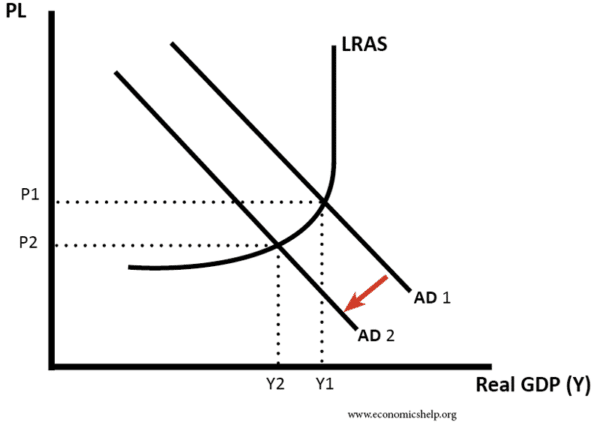
I could have combined 1 or 2 sentences together, but here I wanted to show that short sentences can aid clarity of thought. Nothing is wasted in the above example.
Simple sentences help you to focus on one thing at once, which is another important tip.
3. Answer the question
Quite frequently, when marking economic essays, you see a candidate who has a reasonable knowledge of economics, but unfortunately does not answer the question. Therefore, as a result, they can get zero for a question. It may seem harsh, but if you don’t answer the question, the examiner can’t give any marks.
At the end of each paragraph you can ask yourself; how does this paragraph answer the question? If necessary, you can write a one-sentence summary, which directly answers the question. Don’t wait until the end of the essay to realise you have answered a different question.
Discuss the impact of Euro membership on UK fiscal and monetary policy?
Most students will have revised a question on: “The benefits and costs of the Euro. Therefore, as soon as they see the Euro in the title, they put down all their notes on the benefits and costs of the Euro. However, this question is quite specific; it only wishes to know the impact on fiscal and monetary policy.
The “joke” goes, put 10 economists in a room and you will get 11 different answers. Why? you may ask. The nature of economics is that quite often there is no “right” answer. It is important that we always consider other points of view, and discuss various different, potential outcomes. This is what we mean by evaluation.
Macro-evaluation
- Depends on the state of the economy – full capacity or recession?
- Time lags – it may take 18 months for interest rates to have an effect
- Depends on other variables in the economy . Higher investment could be offset by fall in consumer spending.
- The significance of factors . A fall in exports to the US is only a small proportion of UK AD. However, a recession in Europe is more significant because 50% of UK exports go to EU.
- Consider the impact on all macroeconomic objectives . For example, higher interest rates may reduce inflation, but what about economic growth, unemployment, current account and balance of payments?
- Consider both the supply and demand side . For example, expansionary fiscal policy can help to reduce demand-deficient unemployment, however, it will be ineffective in solving demand-side unemployment (e.g. structural unemployment)
Example question :
The effect of raising interest rates will reduce consumer spending.
- However , if confidence is high, higher interest rates may not actually discourage consumer spending.
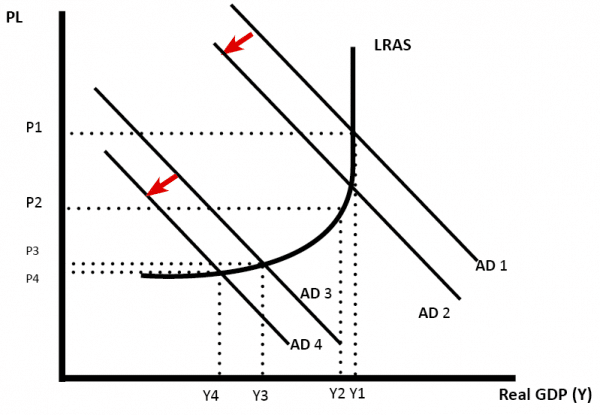
If the economy is close to full capacity a rise in interest rates may reduce inflation but not reduce growth. (AD falls from AD1 to AD2)
- However , if there is already a slowdown in the economy, rising interest rates may cause a recession. (AD3 to AD3)
Micro-evaluation
1. The impact depends on elasticity of demand
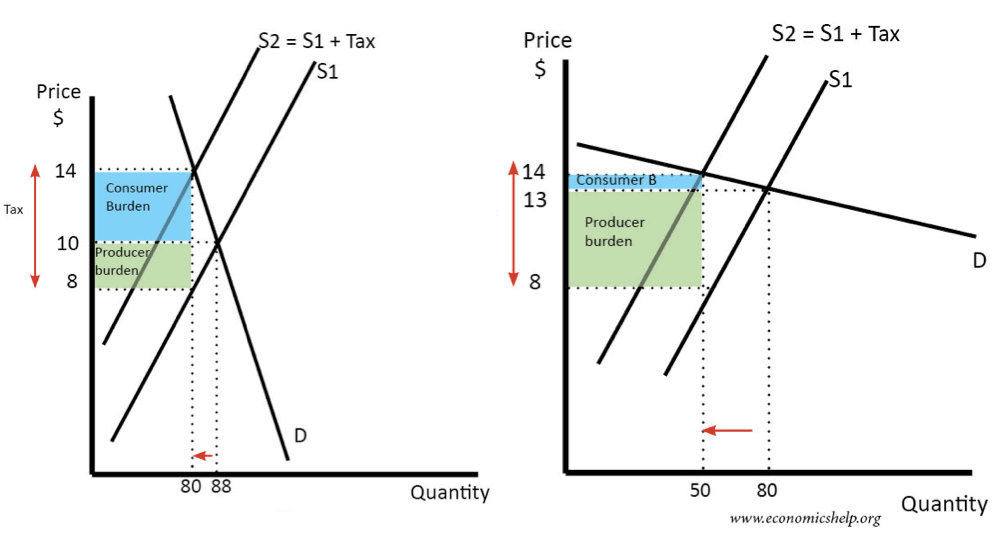
In both diagrams, we place the same tax on the good, causing supply to shift to the left.
- When demand is price inelastic, the tax causes only a small fall in demand.
- If demand is price elastic, the tax causes a bigger percentage fall in demand.
2. Time lag
In the short term, demand for petrol is likely to be price inelastic. However, over time, consumers may find alternatives, e.g. they buy electric cars. In the short-term, investment will not increase capacity, but over time, it may help to increase a firms profitability. Time lags.
3. Depends on market structure
If markets are competitive, then we can expect prices to remain low. However, if a firm has monopoly power, then we can expect higher prices.
4. Depends on business objectives
If a firm is seeking to maximise profits, we can expect prices to rise. However, if a firm is seeking to maximise market share, it may seek to cut prices – even if it means less profit.
5. Behavioural economics
In economics, we usually assume individuals are rational and seeking to maximise their utility. However, in the real world, people are subject to bias and may not meet expectations of classical economic theory. For example, the present-bias suggest consumers will give much higher weighting to present levels of happiness and ignore future costs. This may explain over-consumption of demerit goods and under-consumption of merit goods. See: behavioural economics
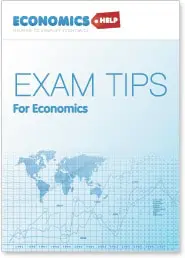
Exam tips for economics – Comprehensive e-book guide for just £5
8 thoughts on “Tips for writing economics essays”
I really want to know the difference between discussion questions and analysis questions and how to answer them in a correct way to get good credit in Economics
Analysis just involves one sided answers while Discussion questions involve using two points of view
This is a great lesson learnd by me
how can I actually manage my time
The evaluation points in this article are really useful! The thing I struggle with is analysis and application. I have all the knowledge and I have learnt the evaluation points like J-curve analysis and marshall learner condition, but my chains of reasoning are not good enough. I will try the shorter sentences recommended in this article.
What kind of method for costing analysis is most suitable for a craft brewery, in order to analyze the cost of production of different types of beer_
Really useful!Especially for the CIE exam papers
Does anyone know how to evaluate in those advantages/disadvantages essay questions where you would basically analyse the benefits of something and then evaluate? Struggling because wouldn’t the evaluation just be the disadvantages ?? Like how would you evaluate without just stating the disadvantage?
Leave a comment Cancel reply
Live revision! Join us for our free exam revision livestreams Watch now →
Reference Library
Collections
- See what's new
- All Resources
- Student Resources
- Assessment Resources
- Teaching Resources
- CPD Courses
- Livestreams
Study notes, videos, interactive activities and more!
Economics news, insights and enrichment
Currated collections of free resources
Browse resources by topic
- All Economics Resources
Resource Selections
Currated lists of resources
Economics Revision Essay Plans
Last updated 17 Dec 2019
- Share on Facebook
- Share on Twitter
- Share by Email
This series of resources provides revision essay plans for a wide variety of essay topics, including synoptic questions.
For the 2019 papers check out our collection of videos on building A* evaluation into your answers
Have you tried our series of more than 50 Quizlet revision activities? Click here to access!
Essay Plan: Limits on Monopoly Power
Topic Videos
Chains of Reasoning and Evaluation: Fuel Prices in the UK
Exam Support
EU Customs Union Membership (Revision Essay Plan)
Practice Exam Questions
Market for Electric Vehicles (Revision Essay Plan)
Mergers and consumer welfare (revision essay plan), air pollution and policies to control (revision essay plan), policies to improve competitiveness (revision essay plan), economic effects of higher interest rates (revision essay plan), current account deficit & policies (revision essay plan), unemployment and policy trade-offs (revision essay plan), case for cutting the national debt (revision essay plan), micro-finance (2019 revision update), essay on advertising and economic welfare, essay on oligopoly and collusion, policies to control inflation.
Study Notes
Why is high inflation a problem?
Revision essay: exchange rate depreciation and macroeconomic objectives, to what extent should full-employment be the main macro policy objective, housing supply (revision essay plan), minimum alcohol pricing (revision essay plan), oligopoly and collusion (revision essay plan), building confidence in writing synoptic 25 mark essays (edexcel), behavioural and neo-classical economics (revision essay plan), barriers to entry and economic profit (revision essay plan), micro and macro impact of a plastic tax (revision essay plan), edge revision webinar: market failure and government intervention, farm subsidies (revision essay plan), competitiveness of the uk motor industry (revision essay plan), labour migration (revision essay plan), financial market failure (revision essay plan), tariff on chinese steel (revision essay plan), policies to improve food affordability (revision essay plan), reducing a trade deficit (revision essay plan), museums and government subsidy (revision essay plan), fiscal policy and inequality (revision essay plan), globalisation and inequality (revision essay plan), economic inactivity (revision essay plan), competition and consumer welfare (essay technique video), essay plan: is the euro the main cause of the crisis in greece and italy, china: successes and failures essay plan, our subjects.
- › Criminology
- › Economics
- › Geography
- › Health & Social Care
- › Psychology
- › Sociology
- › Teaching & learning resources
- › Student revision workshops
- › Online student courses
- › CPD for teachers
- › Livestreams
- › Teaching jobs
Boston House, 214 High Street, Boston Spa, West Yorkshire, LS23 6AD Tel: 01937 848885
- › Contact us
- › Terms of use
- › Privacy & cookies
© 2002-2024 Tutor2u Limited. Company Reg no: 04489574. VAT reg no 816865400.
How to write economics essays
All Economics exam papers at A-Level will have a 25-mark essay-style question, which requires evaluation .
There are different approaches that can be taken in dealing with essay questions, and there is not one essay writing 'template' or 'wizard' that can deal will all questions. However, a commonly used method is to use the first half of your essay to complete the analysis and the second half to evaluate - this is an easy approach to master, and can be used to answer most microeconomic and macroeconomic essays. More on this later.
What the mark scheme tells us
The mark-scheme for a 25-mark question is typically based on the ' levels ' method, with marks allocated in the following way:
4 marks for correctly demonstrating knowledge and understanding of economic concepts and models
4 marks for applying your knowledge and understanding to the 'context' put before you - this case a chocolate manufacturer
8 marks for providing an analysis of the decision (in this case, to raise price) - i.e. what are the expected effects, consequences and results
9 marks for evaluating a decision (question, issue, policy, or problem) based on your judgment , with reference to the problems or risks associated with the decision (policy, problem etc.)
Points to note
- Exam boards often state that, in a 25-mark question, definitions are not specifically required , but it is good practice to define key economic terms that are specific to economics, and to the question.
- Application does not happen in one section of your answer, but should run throughout your answer . In other words, answers that are purely theoretical and detached from the context will not earn high marks.
- For analysis and evaluation, developing a chain of reasoning is essential - ( read more on chains of reasoning ) you have to show exactly how you arrived at a point, judgment or conclusion. A carefully chosen, well draw, accurately explained and fully integrated diagram is essential for effective analysis. This is only possible if you start out by making your assumptions clear.
- For evaluation, it is essential that you provide an alternative approach , (alternative decision, policy etc.) and that your conclusion is not just a summary but a 'weighted' judgment .
- While you only have 30 minutes to write, it is essential you plan your route through your answer - 4-5 minutes planning is worth its weight in gold!
So, lets have a look at a couple of ways to deal with a 25-mark question. Both have similar openings and conclusions, but start out with different assumptions.
' Evaluate the decision by a chocolate manufacturer to raise the price of its 'luxury' box of chocolates .'
There are several factors a chocolate manufacturer will take into account when making a decision about its price. Factors affecting this decision depend on the market structure it operates in, the level of competition it faces, its size and ownership structure. These will affect its main business objective, which in turn will affect its decision regarding price and non-price factors.
We will assume that the chocolate manufacturer's objective is to maximise profits and that it is a price maker and facing a downward sloping demand curve. This means that it is not operating in a highly competitive market, and can raise price without suffering a complete collapse in sales. Profit maximisation arises at the output where MC=MR, which in the diagram is quantity Q. At profit maximisation, the area of supernormal profits (SNP) is area p a b c.
At this quantity, marginal revenue equals marginal cost, which means that any change in price or quantity produced will move it away from profit maximisation. For example, if the chocolate manufacturer increases price to P1, demand will contract along the demand (AR) curve, from 'a' to 'v', resulting in equilibrium quantity falling to Q1. At Q1, MR is greater than MC, which means there is an opportunity cost because the firm could reduce price and produce more, which would lead to an increase its supernormal profits. So, reducung price and producing extra marginal units of output will add to SNP until MC=MR is reached. Hence, in terms of achieving its profit maximising objective, an increase in price above 'P' is clearly counter-productive. This is supported by the probability that demand for 'luxury' chocolates is price elastic, and the producer is operating in the elastic range of the AR curve. As a result, any increase in price will reduce total revenue, and also reduce SNP, which falls to area P1 v w x.
However, there are issues with this analysis. Are the assumptions about the chocolate producer and its market valid? Is the chocolate producer targeting profits, or attempting to achieve a different objective? Will there be negative, and even unexpected consequences of the price rise?
The assumptions regarding the market structure certainly might not hold - in a less competitive market, with fewer firms, the price rise may have a much smaller effect because consumers have less choice. Demand may be more inelastic than predicted, especially if there is loyalty to the brand of chocolate - even though it is a luxury product.
Also, the chocolate producer may have previously been a revenue or sales maximiser and may have decided to change its strategy from revenue or sales maximising to profit maximising. As a revenue or sales maximiser price will be set at a lower level, to stimulate sales or gain more revenue. Management salaries or bonuses may be connected with sales, hence a low price will help the firm achieve this objective. The price increase will move it towards profit maximisation rather than away from it, and help it achieve its new objective. Alternatively, the producer may be a 'profit satisficer' looking to increase its profits but not maximising them. In any of these cases, the price rise might be a rational decision.
It is not known whether rivals will keep their prices on hold, reduce them or raise them to match the firm's price increase. If the firm has a few close competitors, then these firms may be interdependent, meaning it may be more beneficial to keep prices on hold to reduce uncertainty.
Furthermore, the price rise could encourage unwanted new entrants, attracted by the opportunity presented. Raising price could also send a signal to existing producers to launch their own 'luxury' version of the product.
Of course, there may be alternative decisions to consider to help it achieve its objectives, such as changing its non-price activities. So, the price rise could be justified if an effective marketing campaign could help increase demand (AR) and, diagrammatically, shift the AR (and MR) curve to the right, as shown.
In this case, profits are maintained, or even increased, as shown, with lower supernormal profits at area P1 k r m.
Taking a wider view, price rises reduce consumer surplus, and if personal incomes remain constant, consumer will have less income to spend on other goods and services, and the price rise will cause a negative income effect. Of course, a rise in the price of chocolate would not have the same effect as a rise in interest rates or house prices, so the income effect is very small.
In conclusion, the decision to raise prices cannot be judged without understanding the nature of the market, the level of competition and the firm's current objectives, and compared with alternatives. There is also the wider economic context to consider, such as whether the economy is in a recession, with pressure on disposable income, or whether the economy is growing, with consumers feeling confident. There are clearly risks associated with an increase in price, and it might be less risky not to raise price, and put more effort into non-price strategies. However, if the assumptions that the firm is already a profit maximiser, that there are no other changes to its non-price activity, and that the behaviour of other chocolate producers does not change, then a price rise seems unjustifiable as it would fail to achieve its dominant objective - to maximise profits - and raising price would, in this case, be an irrational decision.
Answer two - the alternative answer
We will assume that the chocolate manufacturer's objective is to maximise profits and that it is a price maker and facing a downward sloping demand curve. We will also assume that it currently is not profit maximising, but producing at an output greater than profit maximisation, at output Q, and a lower price, at P in the following diagram. Profit maximisation arises at the output where MC=MR, which in the diagram is quantity Q1, and price P1.
At the quantity Q, while marginal revenue is negative at 'f' and below marginal cost at 's', the chocolate manufacturer still makes a supernormal profit, shown as the area SNP (area Pvwx). Also, at the current price of P, price elasticity of demand is inelastic because, in the diagram quantity demanded, Q at price P is to the right of the mid-point of the demand (AR) curve. Given that, at the mid-point, PED equals (-) 1.0, which is where MR=0, at its current output, PED must be inelastic.
Given these assumptions, a decision to increase price above P will help the manufacturer achieve profit maximisation. Because the firm operates in the inelastic portion of its demand (AR) curve, the planned price rise reduces the quantity demanded, to Q1, but increases total revenue - at least up to the output where MR=0. The reduction in output that follows means that the variable costs of production fall, which means that marginal costs fall (from 's' to 't'), while at the same time marginal revenue increases from 'f' to 't'. Assuming profit maximisation is still the dominant objective, the price rise is clearly beneficial, as it leads to increased profits (area P1a b c) resulting from the lower marginal cost and the higher marginal revenue.
However, there issues with this analysis. Firstly, are the assumptions about the chocolate producer valid, secondly, is the chocolate producer wishing to increase profits, and thirdly, will there be any negative, and even unexpected consequences of the price rise?
The assumptions regarding the market structure certainly might not hold - the market could be much more competitive, and approach perfect competition. This would result in a very different outcome for the producer, especially in terms of a price elasticity of demand, which rises with increased competition. In a more competitive market, there are more choices for the consumer, and any price rise by one firm may result in falling revenue. Demand may be more elastic than predicted, especially because the price rise is for the 'luxury' version of the box of chocolates, where demand is likely to be more elastic.
Also, the chocolate producer may not be a profit maximiser, but may instead be a revenue or sales maximiser, in which case the price rise could move it away from maximising sales or revenue points. If the firm is a large producer where there is a separation of ownership and control, it is more likely that other 'managerial' objectives dominate decision making. If, for example, the firm is looking to maximise sales volume, perhaps because management salaries or bonuses are connected with sales, then a price rise would not be beneficial.
It is not known whether rivals will keep their prices on hold, reduce them or raise them to match the firm's price increase. If the firm has a few close competitors, then the fact that these firms may be interdependent means that it may be more beneficial to keep prices on hold and reduce uncertainty.
Of course, there may be alternative decisions to consider to help it achieve its objectives, such as changing its non-price policy. So, if there is also a successful marketing campaign designed to increase sales, or build a brand, price increases could be postponed until the brand is well established.
In conclusion, the decision to raise prices cannot be judged without understanding the nature of the market and competition and the firm's current objectives, and compared with alternatives. There is also the wider economic context to consider, such as whether the economy is in a recession, with pressure on disposable income, or whether the economy is growing, with consumers feeling confident. There are clearly risks associated with an increase in price, and it might be less risky not to raise price, and put more effort into non-price strategies. However, if all the assumptions listed above are fully met, then a price rise seems justifiable in that the firm can achieve its dominant objective - to maximise profits.
These are two answers which use a similar structure, and common introduction and conclusion - but start with different assumptions, and therefore have a different analysis, and evaluation.
There are other several possible approaches to this question, and other evaluative points that could have been included. For example, there could have been more emphasis on what rivals might do, and there could be more robust questioning about exactly how much the price is being increased by, and whether this is just a temporary strategy. The essay could also have raised the question of the possible external effects arising from less output and consumption (namely fewer negative consumption and production externalities). However, with the time constraint in the examination room, it is not possible to cover every 'blade of grass' and some good points may have to be sacrificed.
Finally, the 'starting point' and assumptions could have been different, which would have led to a different analysis.
Conclusion and key takeaways
Having a structure to help you tackle an essay-style question is very important.
Both essays use the same four-part structure :
- Part 1, the analysis - making assumptions, and using the correct diagram to show how a decision or policy will work to achieve an objective.
- Part 2, the evaluation begins with ' the bridge ' of the essay - assumptions are questioned and probably changed.
- Part 3 the full evaluation , where an alternative or alternatives are explained based on the change of assumptions.
- Part 4, the conclusion , where the evidence or strength of argument is assessed, and the decision, policy or assertion is 'accepted in full', 'accepted in part' or 'rejected' in favour of the alternative(s).
Finally, it is clear how important diagrams are in analysis and evaluation, and helping develop a logical chain of reasoning - so ensure that you have undertaken enough practice in constructing, applying and integrating diagrams to a wide range of past questions.
Other tips:
How to study economics
How to write the perfect conclusion
How to answer data response questions
How to include chains of reasoning
- Find A Tutor
- Geneva Tutors
- Lausanne Tutors
- Zurich Tutors
- Basel Tutors
- Online Tutors
- Maths Tutors
- Chemistry Tutors
- Physics Tutors
- Biology Tutors
- English Tutors
- History Tutors
- Geography Tutors
- Language Tutors
- Special Educational Needs
- Residential Tutors
- Primary School
- School Entrance Exams
- Middle School
- Combined Science
- Maths AA and AI
- IB Internal Assessment
- Environmental Systems & Societies (ESS)
- Sports, Exercise & Health Science
- Computer Science
- Global Politics
- Digital Society
- Business Management
- Visual Arts
- English A/B
- English Oral (IO)
- German Oral (IO)
- French Oral (IO)
- Spanish A/B
- French Ab Initio
- German Ab Initio
- Spanish Ab Initio
- IB Extended Essay
- IB Theory of Knowledge
- University Applications
- Our Approach
- Happy Parents
- School Choice
- Become a Tutor
How to Nail Your IB Economics Paper 2 – Practical Tips
By TutorsPlus

Nailing your IB Economics Paper 2 is as important as the other components of your final assessment. It is accountable for 30%-40% of your success (depending on whether you are doing SL or HL Economics).
This complex exam poses a challenge to many students. Fear not, with some of the practical tips you’ll find in this post, you’ll ace your IB Economics assessment like a pro.
Paper 2 is very demanding since it requires you to demonstrate your understanding of economic theory, to apply your knowledge in real-life situations, as well as evaluate economical processes and their consequences.
So dive into this article along with its companion piece “How to nail paper 1.”
The Structure of IB Economics Paper 2
IB Economics Paper 2 is a combination of data response questions and an extended response question. Students have two questions but need to answer only one of them. These questions feature two snippets of news articles, which provide some data for practical application.
Each question refers to one of the four sections of the IB Economics syllabus and is broken into a-g sections. They, as a rule, contain the following questions:
- Define two terms (4 marks);
- Based on the information from a news article, calculate (3 marks) and draw a diagram (2 marks);
- Using a diagram, explain how… (4 marks);
- Using a diagram and the information from the text, explain …(4 marks);
- Using a diagram and the information from the article, explain how…(4 marks);
- Using a diagram, explain what…(4 marks);
- Using the information from the article and the knowledge of economic theory, discuss … (15 Marks).
In total, IB Economics Paper 2 awards 40 marks, out of which 25 bring short-answer questions and 15 – the final essay-like question. These marks weigh 30% of the total grade for HL students and 40% from the SL. Overall, students have 1 hour and 45 minutes to complete the assignments.


How to Nail Your IB Economics Paper 2: Practical Tips
Now that the structure of the questions is clear, let’s take a closer look at each section.
Definitions (Section a)
The opening section of Paper 2 is give-a-definition questions. Typically, there are two such questions, and each brings 2 marks. Occasionally, a question may ask to specify the functions of an institution or organization, such as a central bank.
To gain two points for each definition, it is not enough to provide a simple answer. You should also give an example, provide a brief explanation, and, when appropriate, an equation.
Calculation (Section b)
In your exam, you will be asked to do some calculations. For example: ‘Using the data about national income specified in an article, calculate nominal GPD sticking to the expenditure approach’. The majority of these calculations require just the basic mathematical functions (plus, minus, multiply, divide) yet calculators are allowed during the examination.
When doing these calculations, you need to be exact – unless otherwise specified in the question, show two decimal places. If you use formulas, make sure to include them. Also, you need to show full working out.
Diagrams (Section b, c-f)
Diagrams are an essential part of Paper 2 – typically, sections from b to f have something to do with them. Naturally, you need to master how to draw and describe diagrams to nail your IB Economics assessment.
Sections c-f reward 4 marks each, 2 of which are for drawing a diagram and 2 for explaining it. This explanation shouldn’t be too detailed – one or two paragraphs will suffice. When it comes to drawing, make sure to stick to the following tips:
- Always use a ruler to draw the axes of a diagram as well as linear lines;
- Remember to fully label your diagram (axes, important points, intersections, etc.). Use standardized abbreviation (GDP, for instance) but don’t shorten labels in other cases (use Price instead of just ‘P’). Also, don’t forget to specify measuring units ($, kg, etc.);
- Show your diagrams as dynamic, not static. If an indicator changed over a period of time, you need to appropriately reflect this change.
- When it comes to the essay-like section g, a diagram is not compulsory. Nevertheless, if you feel that it can help you with a more detailed answer, you can include it.
Explain (Section c-f)
The sections from c to f feature the ‘explain’ type of questions. To be more exact, they feature command terms, which indicate the depth of your answer. The Economics guide from the IBO specifies 34 such commands, but in Paper 2, you will be likely to come across the following most frequent terms: analyse, compare, compare and contrast, describe, determine, discuss, explain, evaluate, list, show, etc.
It is vital that you understand what command terms require you to come up with an adequate answer.
For example, ‘explain’ implies that you need to give a detailed account featuring reasons and causes.
Evaluate, on the other hand, means that you need to provide your opinion on a situation, including highlighting its pros, cons, and limitations.
If your question commands ‘list’, you don’t have to go into details. It’s enough to write a few bullet points with brief commentaries for each.
Do not go into more details than required. This will waste time and you will not be awarded additional marks for it.
Discuss (Section g)
Section g of Paper 2 is very similar to section b of Paper 1. Both intend to assess how well you are able to apply the economic theory you learned in class to real situations. In order to nail your IB Economics Paper 2, we suggest that you use the DEEDE method we described in detail in our previous IB Economics Paper 1 article .
The acronym DEEDE means the following:
- D efinitions – give a definition of economic terms and keywords related to your question. As a rule, some of these terms are mentioned directly in the question. You may also need to define other terms essential to your answer.
- E xplanation – you need to show that you are able to apply relevant economic concepts and theories to answer the question.
- E xample – your question will already feature an example (news article excerpt) so you don’t need to provide it on your own. However, you need to show that you are able to interpret data, see the correlation between two or more variables, and use it for calculations and diagram drawing when applicable.
- D iagram – depending on your specific question, providing a diagram may be beneficial, but it is not a requirement. If you already have a diagram based on the same data for one of the previous sections, you can simply refer to it but don’t draw it again.
- E valuate – a command term in the question will give you an idea of what is required (compare, contrast, discuss, evaluate, examine, justify, etc.). In a simplistic way, evaluation means providing a judgment about the strengths and weaknesses of an action or process, its consequences, or alternatives. Your answer should be based both on data from the text and economic analysis, and all of your arguments must be fully justified.
You will have a sufficient amount of time to formulate your answer – as a rule, it takes 45 minutes to complete the task, so make sure your answer has a good flow, depth, and clarity.
How to Nail Your IB Economics Paper 2 with Tutors Plus
Preparation for IB Economics Paper 2 is not without its challenges. On one hand, Paper 1 and Paper 2 have many similarities – you need to focus on definitions, diagrams, and evaluations of certain processes, concepts, and actions. On the other hand, Paper 2 features calculations, and many students struggle with those.
One more thing that makes it difficult to nail IB Economics Paper 2 is changes in the syllabus. Up until 2021, Paper 2 focused only on the International Economics and Development Economics units of the syllabus. Now, the units of the syllabus are different, and Paper 2 utilizes not just two but all four units. It makes it hard to practice with past papers since their questions may no longer be relevant, let alone they don’t cover the entire programme.
How to properly prepare for Paper 2 then? Our solution is tutor assistance. An IB Economics tutor is able to estimate where you’re standing and where you should be going. This concerns not only your theoretical knowledge but also practical skills and your ability to analyse since all of them are equal parts important to nail your Paper 2.
Tutors Plus is your reliable source of IB tutors – knowledgeable, experienced, and committed to your success. Contact us at [email protected] or 022 731 8148 and let us help you be fully equipped for one of the most important exams in your life.
Popular Posts

English IO – How to Ace Your IB English Literature & Language Oral

Tips to get a Top Grade in Your IGCSE English

How to get a top score in your IB TOK Exhibition

IGCSE Maths Revision Tips To Help You Today

What is the IA, EE or TOK? Everything you need to know about the IB written assignments

Maths Anxiety – How Parents Can Help
More articles from our expert tutors.

6 top tips for a successful parents’ evening

Tips on How to Get Top Marks in IB Spanish Language B
Find a Tutor Today
" * " indicates required fields
Step 1 of 5
Find the best support for your family
IB Economics HL/SL Exam Structure
IB Economics Higher Level exams consist of 3 Papers (P1 – 30%; P2 – 30%; P3- 20%)
IB Economics Standard Level exams consist of 2 Papers (P1 – 40%; P2 – 40%).
20% of your IB Economics SL and HL course grade depends on your Economics Internal Assessment .
Paper 1 – Essay paper
Duration: 1 hour 30 minutes + 5 minutes reading time during which you are not allowed to highlight the text/questions, make notes or start any of the answers
Structure of paper 1:
- Section A, where you choose 1 question out of 2, which covers Microeconomics part of the syllabus.
- Section B, where you choose 1 question out of 2, which covers Macroeconomics part of the syllabus.
- Each question in both A and B sections consists of two (a) and (b) parts, which are compulsory. Part (a) will usually be an “explain” type of question. Part (b) will mostly be a “discussion” or “evaluation” type of question.
Weight: 1 question = 25 marks, of which:
- 10 marks for part (a)
- 15 marks for part (b)
In total, Paper 1 = 50 marks.
Paper 2 – Data response
Duration: 1 hour 30 minutes + 5 minutes reading time during which you are not allowed to highlight the text/questions, make notes or start any of the answers
Structure of paper 2:
- Section A, where you choose 1 question out of 2, which covers International Economics part of the IB Economics syllabus.
- Section B, where you choose 1 question out of 2, which covers Development Economics part of the IB Economics syllabus.
- Each question in both A and B sections consists of four – (a), (b), (c), (d) parts, which are compulsory. Part (a) will usually ask to define 2 economic terms. Parts (b) and (c) will be “explain” type of questions. Part (d) will mostly be “evaluate” or “discuss” type of question.
Weight: 1 question = 20 marks, of which:
- 4 marks for part (a) [2 marks for each definition]
- 4 marks for part (b)
- 4 marks for part (c)
- 8 marks for part (d)
In total, Paper 2 = 40 marks.
Paper 3 – Maths paper (HL only)
Duration: 1 hour + 5 minutes reading time during which you are not allowed to highlight the text/questions, make notes or start any of the answers
Structure of paper 3:
- You choose 2 questions out of 3, which cover all of the IB Economics HL parts of the syllabus: Microeconomics, Macroeconomics, International Economics and Development Economics.
Weight: 1 question = 25 marks.
In total, Paper 3 = 50 marks.
- International
- Schools directory
- Resources Jobs Schools directory News Search
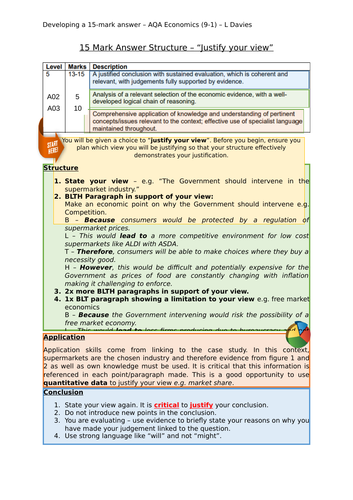
15 Mark GCSE Economics Exam Question Structure
Subject: Economics
Age range: 14-16
Resource type: Other
Last updated
19 June 2018
- Share through email
- Share through twitter
- Share through linkedin
- Share through facebook
- Share through pinterest

Creative Commons "Sharealike"
Get this resource as part of a bundle and save up to 25%
A bundle is a package of resources grouped together to teach a particular topic, or a series of lessons, in one place.
15 mark Q - AQA GCSE Economics - (9-1)
Bundle of 3 unique 15 mark questions with scaffolding and structure included.
Your rating is required to reflect your happiness.
It's good to leave some feedback.
Something went wrong, please try again later.
Really helpful. Thank you
Empty reply does not make any sense for the end user
Extremely helpful, thank you!
Really useful resource. Thanks for sharing.
dannytheinventor
Report this resource to let us know if it violates our terms and conditions. Our customer service team will review your report and will be in touch.
Not quite what you were looking for? Search by keyword to find the right resource:

IMAGES
VIDEO
COMMENTS
How should you structure a 15 mark question? Because of multiple requests from students, I have created a 15 mark model answer in style of IB Economics paper 1. This is based on the new IBDP Economics syllabus. For 24 model answers to 15 mark paper 1 questions, check out the links below: Paper 1
The IB Economics Paper 1 Essay Structure. In the new syllabus (May 2022 exams onward) and get to choose 1 out of 3 questions, chosen from any of the 4 units. Paper 1 is worth 20% of your final for HL students and 30% for SL students. You'll get get 75 minutes (1 hour and 15 minutes).
Model 15-Markers. Unlock your potential with these IB economics model answers, designed to provide a deeper understanding of key topics and real-world examples. By studying these model answers, you'll gain a solid foundation in economic concepts, learn how to structure your essays effectively, and develop critical analysis skills. As you ...
IB Economics Paper 1 & 2 - 15 Marker Question - Exam Technique. IB Economics Paper 1 & 2 - 15 Marker Question - Exam Techniquehttps://www.youtube.com/watch?v...
No economic rigour. Step 5: In-Body Evaluation. This applies especially to the 15 mark essays for A-Level Economics. A total of 5 marks is catered for Evaluation. Students should attempt to achieve about 2-3 in-body evaluation marks by pointing out how the thesis and anti-thesis points may not be true due to certain assumptions made that may ...
6. Evaluate: 15 mark questions often require you to evaluate a specific issue or policy. When evaluating, consider both the positive and negative effects, and provide evidence to support your argument. 7. Write legibly and neatly: Finally, make sure your answer is legible and well-organized. Write in clear, concise sentences and use headings ...
The 15 mark question for Edexcel Economics A is where I see students drop most marks. Usually there are a few key reasons for this: Poor time management. Misreading the question. Short length of analysis or evaluation. Other issues. To help my students, I have posted a model answer below.
Some tips for writing economics essays Includes how to answer the question, including right diagrams and evaluation - primarily designed for A Level students. 1. Understand the question. Make sure you understand the essential point of the question. If appropriate, you could try and rephrase the question into a simpler version.
Body Part 1: The "course concepts" part. Include 3 to 5 course graphs that help you answer your RQ. As you write, you'll be using economics diagrams and concepts to help to answer your question. By the end of each tool-section, you'll want to include some data and analysis on your case.
WRITING ASSIGNMENTS IN ECONOMICS 970 In Sophomore Tutorial (Economics 970), you will receive several writing assignments including a term paper, an empirical exercise, short essays, response papers, and possibly a rewrite. Below is a description of these types: • Term Paper (10-15pp.). In all tutorials, you will be required to write a
Economics Revision Essay Plans. This series of resources provides revision essay plans for a wide variety of essay topics, including synoptic questions. For the 2019 papers check out our collection of videos on building A* evaluation into your answers. Have you tried our series of more than 50 Quizlet revision activities?
Points to note. Exam boards often state that, in a 25-mark question, definitions are not specifically required, but it is good practice to define key economic terms that are specific to economics, and to the question. Application does not happen in one section of your answer, but should run throughout your answer.In other words, answers that are purely theoretical and detached from the context ...
15 Marker - Paper 1 & 2 - Edexcel A Level EconomicsInstagram: @econplusdalTwitter: https://twitter.com/econplusdalFacebook: https://www.facebook.com/Econplus...
Unlike part (a) questions which are weighed at 10 marks, and tests your knowledge and understanding, application and analysis, and your selection, use appropriate skills and techniques.Part (b) requires you to not just be thorough with your theoretical understanding but requires a critical discussion and/or evaluation of the economic concept being tested, you should also be able to synthesise ...
Using the information from the article and the knowledge of economic theory, discuss … (15 Marks). In total, IB Economics Paper 2 awards 40 marks, out of which 25 bring short-answer questions and 15 - the final essay-like question. These marks weigh 30% of the total grade for HL students and 40% from the SL.
IB Economics HL/SL Exam Structure. IB Economics Higher Level exams consist of 3 Papers (P1 - 30%; P2 - 30%; P3- 20%) ... Paper 1 - Essay paper. Duration: 1 hour 30 minutes + 5 minutes reading time during which you are not allowed to highlight the text/questions, make notes or start any of the answers. ... 15 marks for part (b) In total ...
Step 1 Determine a level. Start at the lowest level of the mark scheme and use it as a ladder to see whether the answer meets the descriptor for that level. The descriptor for the level indicates the different qualities that might be seen in the student's answer for that level. If it meets the lowest level then go to the next one and decide ...
Exam technique: Essay skills. Your exam answers are marked using KAAE (Knowledge, Application, Analysis and Evaluation). It is important to understand and to master all these skills in order to do well in the exam. A good economics paragraph will include all four skills (except in questions which don't require evaluation).
Point 1: In each point, you are looking to make your point and explain it through a chain of analysis and (often) a graph. Adding a fact or information about the current state of the economy helps achieve application points. For statistics on the UK economy, I usually use the website Trading Economics. Particularly where the point feels short ...
Exam technique: A-level Papers. A-level Economics has three exam papers, each is marked out of 100 and is 2 hours long. Paper 1 and 2 have the same format: Section A, multiple choice and short answer questions, Section B, data response questions , and Section C, an essay-style question. Paper 1 tests your know of microeconomics, Theme 1 and ...
A step by step, tried and tested structure for students to follow to complete 9 mark and 15 mark exam questions. This has been designed for AQA A-level Economics paper 1 and paper 2. As a regular examiner of Paper 1, I have refined this resource to ensure it allows students to achieve maximum marks on these questions.
Subject: Economics. Age range: 16+. Resource type: Assessment and revision. File previews. docx, 18.74 KB. Structure Strip to support students in the response of 8 mark examine questions for Edexcel A Level Economics A specification. Tes paid licence How can I reuse this?
15 Mark GCSE Economics Exam Question Structure. I have attached a structure for a 15 mark answer for the new AQA (9-1) GCSE Economics Specification that I am using with my students. I found there was little support online from AQA in regards of how to write a 15 mark question on the new specification so I hope it will prove somewhat useful.